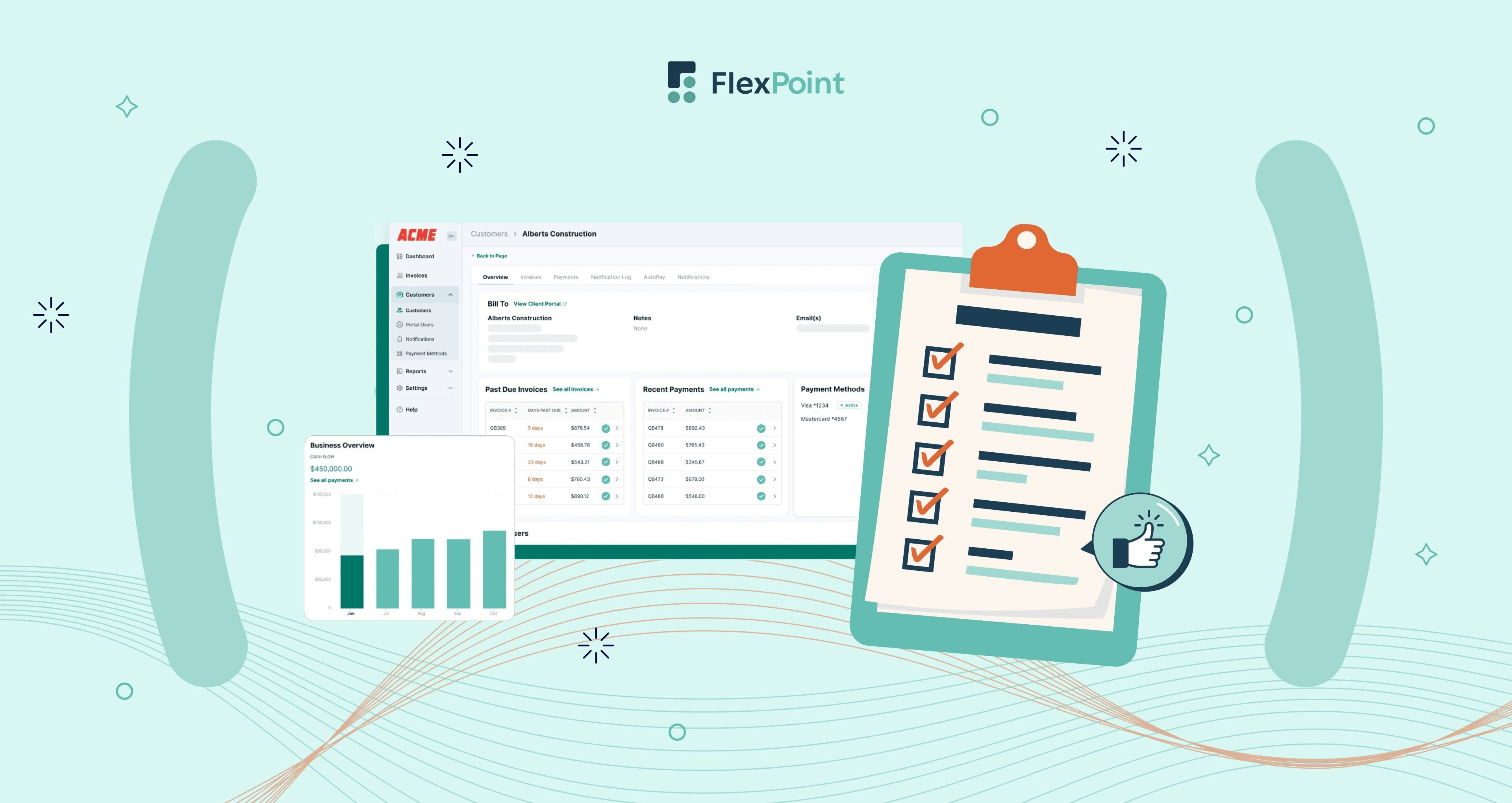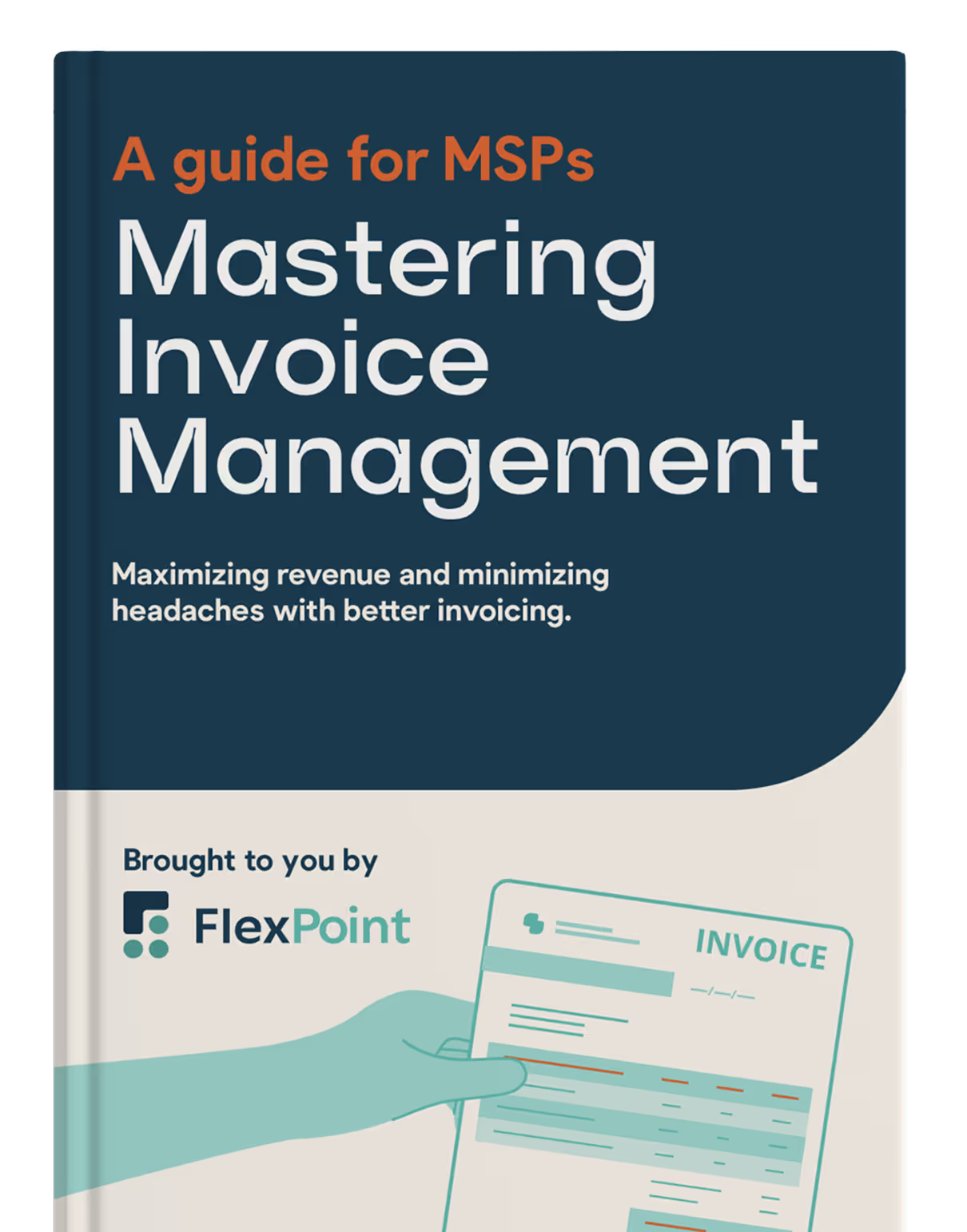MSP Usage-Based Pricing: A Flexible Model for Modern Service Delivery

A 2025 360iResearch report on billing trends found that usage-based billing software is projected to grow from $6.86 billion in 2025 to $9.89 billion by 2030, signaling strong demand for pricing models that scale with client needs. MSPs are part of this movement, as they look for better ways to serve clients with variable consumption patterns while maintaining profitability.
In a usage-based model, clients pay for exactly what they use, whether it’s cloud storage, support hours, or endpoints managed, rather than a fixed, all-inclusive fee.
This structure aligns billing more closely with the actual value delivered, making costs feel more transparent and easier for clients to justify.
Flat-rate plans still have their place, but they don’t always account for how clients actually use services. Usage-based pricing offers an alternative: one that supports client growth, encourages upselling, and provides both parties with greater clarity around the cost-to-value relationship.
However, it also introduces new risks. MSPs must carefully track service consumption across tools and prepare for month-to-month revenue fluctuations.
In this article, we delve into what usage-based pricing means for MSPs, the benefits and challenges of this model, and strategies to implement it effectively in modern service delivery.
{{toc}}
What Is Usage-Based Pricing for MSPs?
Usage-based pricing for MSPs involves charging clients according to the amount of service they consume, rather than a flat fee. For example, an MSP might bill by the gigabyte of data backed up, per helpdesk ticket resolved, or per endpoint managed.
In this model, the monthly invoice reflects actual usage metrics, such as 500 GB stored or 20 tickets closed, with pricing tied to each unit of usage. This is a departure from flat-fee or unlimited service plans, where clients pay the same amount regardless of utilization.
Such a model is most applicable when service usage varies significantly between clients or over time. For instance, cloud infrastructure management can be billed on a “pay-as-you-go” basis, based on the number of compute hours or storage used, mirroring how public cloud providers charge.
Conversely, stable services with predictable workloads might still use flat rates for simplicity. Many MSPs employ a hybrid billing approach, providing a base level of service for a fixed fee and layering on usage-based charges for variable components.
The key is to apply usage billing where it aligns cost with value, ensuring clients pay proportionally to the services they consume.
{{ebook-cta}}
4 Benefits of Usage-Based Pricing in MSP Operations
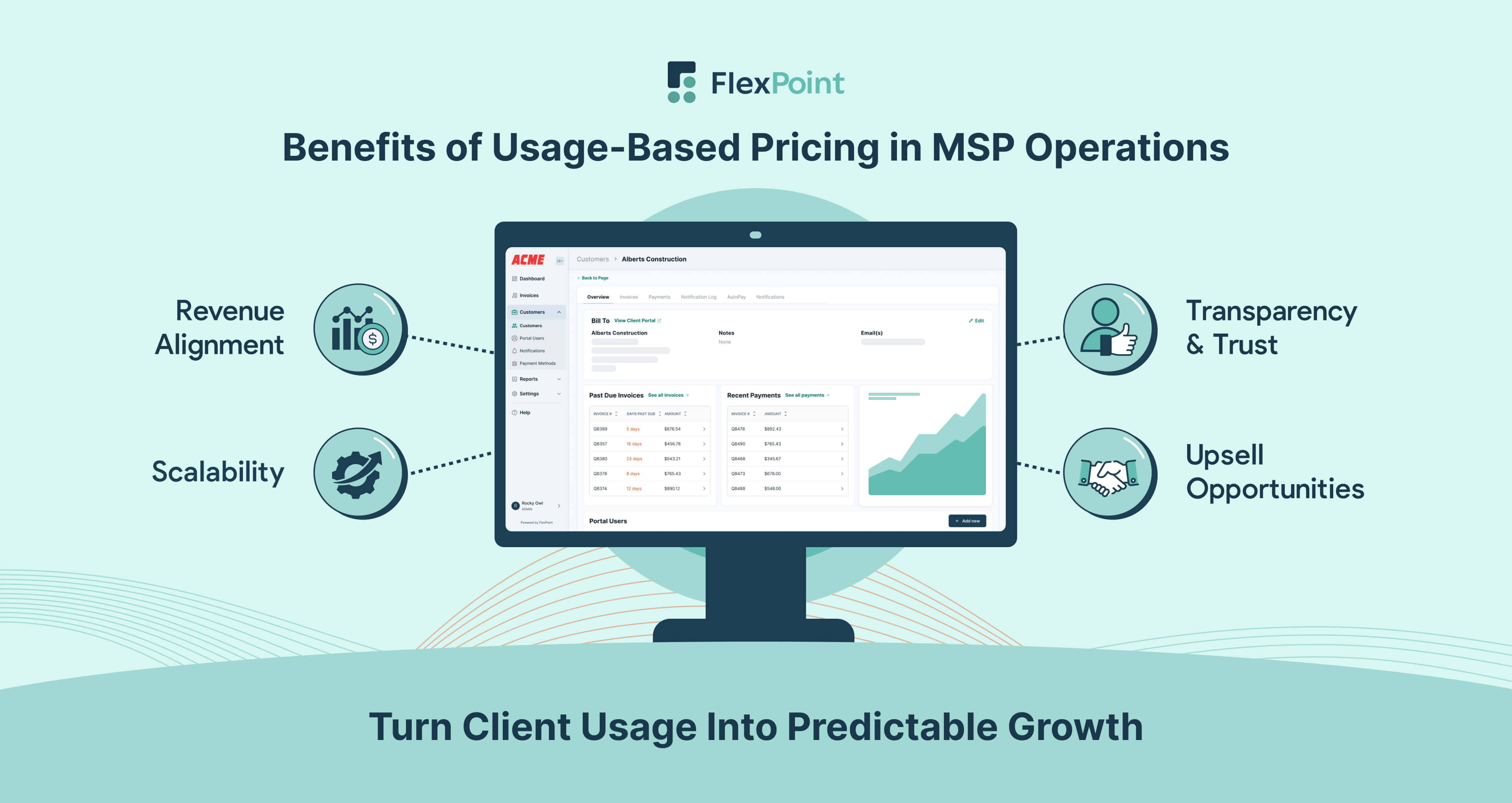
A well-implemented usage-based pricing model can offer several compelling benefits for an MSP’s business and its clients:
1. Revenue Alignment:
Revenue naturally grows as clients consume more services. This alignment means the MSP is compensated in proportion to the work done and resources used, preventing undercharging on high-utilization accounts.
It creates a fair relationship where clients pay for what they get, and the provider isn’t left covering the cost of unanticipated extra work. Over time, this can improve profitability on heavy-use accounts while keeping lower-usage clients affordable.
2. Scalability:
Usage-based pricing automatically scales when a client’s needs expand. As a client adds employees, devices, or data, their billing increases accordingly without requiring a contract renegotiation.
This fosters a partnership mindset, where the MSP’s revenue grows in tandem with the client’s business. It also offers flexibility if a client occasionally uses fewer resources. By adapting fluidly to fluctuations, the model can accommodate seasonal or unpredictable needs in a way that fixed pricing cannot.
3. Transparency and Trust:
Clients appreciate detailed, itemized bills showing actual service consumption. Seeing exactly how usage drives costs builds trust and reduces billing disputes. Clear line items let clients directly connect what they used to what they’re paying, reducing confusion and proving the MSP’s value.
When clients see a direct link between their consumption and the invoice, it reinforces the credibility of the billing process and can boost long-term loyalty.
4. Upsell Opportunities:
Usage patterns naturally indicate when a client may require additional services. For example, suppose a client consistently reaches a usage limit (such as nearing a storage quota or exceeding typical support hours). In that case, it initiates a conversation about upgrading to a higher tier or adding resources.
In this way, pay-as-you-go models create organic upsell moments tied directly to the client’s demonstrated needs. Rather than a hard sell, the usage data itself prompts a discussion about adjusting their plan, benefiting the client with more service and the MSP with higher revenue.
4 Common Challenges of Usage-Based Billing
While usage-based pricing can align payments with value, MSPs must navigate several challenges to make it work effectively:
1. Complex Tracking Requirements:
Accurately monitoring client usage is critical and can be complex. MSP services encompass multiple tools, including ticketing systems, remote monitoring platforms, and cloud management portals.
Pulling together data (like hours worked, tickets resolved, or gigabytes used) from these siloed systems is difficult without automation. If done manually, usage tracking can quickly become a logistical nightmare. Errors or missing data in this process can result in revenue leakage and unhappy clients.
Ensuring all billable consumption is captured requires integrating systems or using a unified billing platform. For example, you might need to compile hours from a PSA, device counts from an RMM, and storage usage from a cloud portal. This is a tedious task without automation.
2. Scope Creep and Overuse:
Pay-as-you-go can encourage clients to consume more services, as every extra request is billed later. This can strain the MSP’s team if not managed. For instance, a client might open an unusually high number of support tickets in one month, overwhelming the helpdesk before the billing catches up.
It’s wise to set fair usage policies or caps and communicate them clearly to prevent surprises and ensure workloads remain sustainable.
By defining what constitutes reasonable use (and flagging extreme cases), the MSP protects itself from burnout while the client avoids a shocking bill.
3. Unpredictable Revenue:
Month-to-month income can fluctuate under usage-based billing. If a client’s usage drops, so does that revenue; a spike means an unexpected boost. This variability makes cash flow less predictable, complicating budgeting and financial planning.
MSPs may need to maintain some fixed fees or reserve funds to buffer these swings. Track usage trends and consider setting minimum charges, so that even in slower months, the basics are covered and sudden dips don’t jeopardize the business.
4. Manual Invoicing Risks:
Handling usage billing manually is time-consuming and prone to mistakes. Over—or under—charging clients due to manual errors leads to payment disputes and revenue loss. These processes also don’t scale as the MSP grows, so automation is essential to make a usage-based model viable.
Relying on spreadsheets and manual calculations each month can result in missed billable items or incorrect charges, eroding client trust. Investing in billing software or integrations is virtually a must once you move to this model.
Usage-Based Pricing vs. à La Carte vs Hourly Break-Fix Billing Model
In addition to usage-based pricing, MSPs have long employed other billing models, such as à la carte and hourly break-fix support. It’s helpful to understand how these approaches compare in practice.
To once again clarify, the usage-based pricing model involves charging clients according to actual consumption of services (e.g., per GB of backup or per support ticket).
Bills fluctuate based on usage, which aligns costs directly with value delivered. For clients with variable needs, it provides flexibility: heavy users pay more, light users pay less.
Here is how that model compares to à la carte and hourly break-fix pricing:
- À la Carte Pricing: An à la carte model lets clients choose individual services at set prices, offering flexibility and potential cost savings. However, MSPs often face slim margins when clients opt for only low-value options. This approach can also complicate operations due to varied service packages. Many MSPs now use à la carte add-ons alongside a base plan to keep offerings manageable and sustainable.
- Hourly Break-Fix: The break-fix model charges clients per incident, with no recurring contract, making it an appealing option for small businesses with occasional IT needs. While it can generate high one-time fees, it offers no revenue stability or proactive service. Unpredictable income and low client retention rates can be significant challenges for MSPs using this model. Today, most providers see break-fix as outdated and reserve it for limited or legacy use.
Each model serves different client types and business goals:
- Hourly break-fix offers flexibility but lacks recurring revenue and client retention
- À la carte pricing allows customization but often results in inconsistent packages and lower margins
- Usage-based pricing strikes a balance: it supports proactive service delivery while letting costs scale with actual use
Some MSPs combine these models to strike a balance between flexibility and stability. For instance, you might offer a flat-rate base plan (covering essential services) and then charge usage-based fees for extras, such as additional cloud storage or projects. Some also use tiered packages with à la carte add-ons, or maintain a very limited break-fix option as a last resort. The right mix depends on your client base and business goals.
The key is to ensure your pricing strategy remains profitable and aligns with the value you deliver, whether that’s through predictable flat fees or scalable, consumption-driven charges.
How to Implement Usage-Based Pricing Effectively: 5 Proven Steps
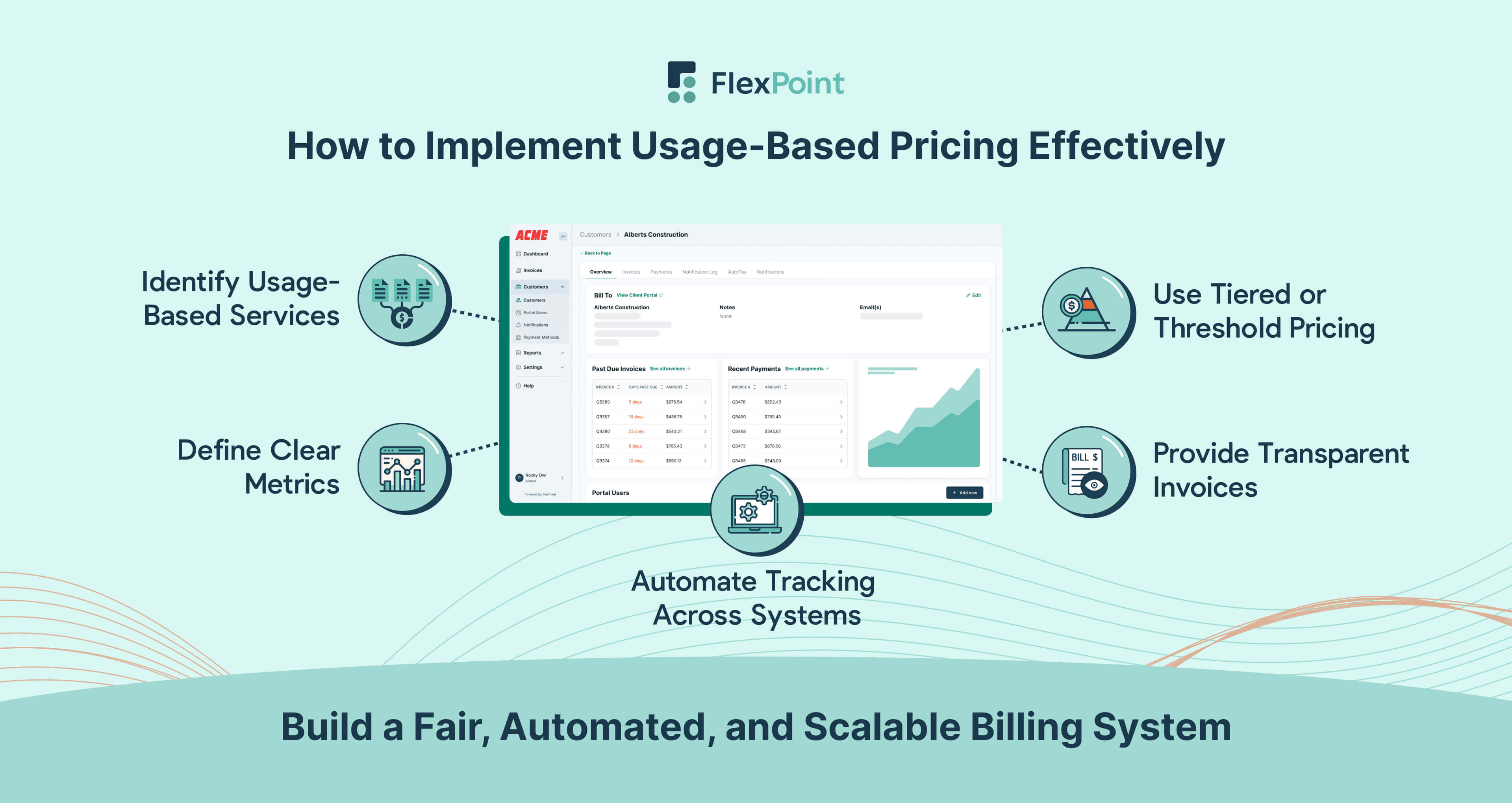
Adopting usage-based pricing in an MSP practice requires careful planning and the right tools.
Below are key steps and best practices to implement this model successfully:
1. Identify Which Services Are Suitable for Usage Billing:
Not every service is a good fit for usage-based billing. Focus on offerings that have clear, measurable consumption and variable use among clients.
For example, cloud resources (such as storage or CPU hours), data backup volumes, or the number of support tickets can be billed per usage unit.
On the other hand, IT services with mostly fixed effort or cost (like routine monitoring or basic support for a stable number of devices) are better kept as a flat rate.
Often, a hybrid approach makes sense: keep core services at a fixed fee and make only the volatile components usage-based. The goal is to apply usage-based pricing that fairly reflects actual work and cost, ensuring that heavy users pay more and light users pay less.
For example, if you manage cloud infrastructure for clients, you might bill based on resource hours or storage used, rather than a flat server fee, ensuring the charge scales with the workload.
2. Define Metrics and Measurement Standards Clearly:
Once you’ve chosen the services to bill by usage, decide exactly how you will measure and bill each one. Choose a simple unit for each (e.g., per ticket, per GB, per endpoint) and make sure everyone understands it.
It’s also important to determine when and how usage is calculated. For instance, this could be as a monthly total or a snapshot at month-end.
Document these definitions in your proposals and contracts to avoid confusion. For instance, clarify whether a "support ticket" refers to any request or only those that require on-site intervention, so clients know exactly what triggers a charge.
Clear metrics ensure clients know what they’re paying for and prevent disputes over the bill.
3. Automate Usage Tracking Across Systems:
Manually compiling usage data isn’t sustainable at scale. Instead, integrate your PSA, RMM, and cloud platforms to capture service activity in real time. FlexPoint connects directly to these systems, pulling data from your PSA software (such as ConnectWise, Autotask, HaloPSA, SuperOps) and accounting software (such as QuickBooks Online, QuickBooks Desktop, Xero), and then automatically applies your billing logic.
Whether it’s ticket counts, gigabytes consumed, or device totals, usage is tracked and converted into invoice-ready line items without manual effort. This reduces the risk of missed revenue, speeds up invoicing, and ensures that every bill accurately reflects the client's usage.
Automation also enables you to set up proactive alerts, such as when a client approaches a usage threshold, ensuring timely and transparent billing
4. Use Tiered or Threshold Pricing to Create Predictable Upsells:
Introduce tiered plans or usage thresholds to strike a balance between flexibility and predictability. For example, you might include a certain amount of usage in a fixed monthly fee, then charge a set rate for any usage exceeding that amount. This provides clients with a stable base cost while still charging an additional fee for heavy usage.
You can also offer volume discounts at higher usage levels to reward growing clients. Some MSPs also set a minimum monthly charge or include a base amount of service, so even months with very low usage still cover basic costs.
Tiered pricing prevents sudden fluctuations in bills and ensures that higher consumption is consistently accounted for in your revenue.
5. Provide Clear, Itemized Invoices:
Make your invoices transparent by listing each usage-based charge separately. Instead of a single lump sum, break down the bill: for example, show “Backup Storage – 2,000 GB @ $0.10/GB = $200” as its own line item.
Here’s an example of how an invoice with proper itemization might look:
Sample Usage-Based Invoice – June 2025
Client: [Client Name]
Invoice #: 2403722
Billing Period: June 1–30, 2025
Issued By: [Your MSP Name]
Due Date: July 15, 2025

Subtotal: $6,469.00
Taxes (5%): $323.45
Total Due:$6,792.45
This level of detail helps clients understand exactly what they’re paying for and significantly reduces any potential billing disputes. With MSP-specific billing software, you can automate the creation of these detailed invoices.
FlexPoint’s platform makes it easy to include usage breakdowns on every bill in the branded client payment portal, so nothing is left ambiguous.
6. Monitor Trends and Adjust Pricing Over Time
After rolling out usage-based pricing, keep an eye on how it’s working. Regularly review usage reports and financial outcomes for each client to ensure optimal performance and results. If a client’s bills are spiking dramatically or their usage patterns change, be ready to adjust.
You might introduce a new tier, adjust rates, or recommend an alternative plan if necessary. Modern billing platforms provide dashboards for tracking key metrics, enabling you to identify trends and refine your model.
Be sure to communicate with clients as well; their feedback on the billing experience can guide fine-tuning of your model, ensuring it remains fair and sustainable for both parties. The goal is to stay flexible. Use the data to ensure your pricing remains fair, profitable, and aligned with the value delivered.
Conclusion: Aligning Billing with Value Through Usage-Based Pricing
Usage-based pricing represents a powerful way for MSPs to align their billing directly with the value delivered to clients.
By charging for the actual consumption of services, MSPs shift the billing conversation to one about tangible outcomes: gigabytes protected, devices managed, and tickets resolved, rather than abstract fees. This model introduces a high degree of flexibility into service delivery.
Clients appreciate the ability to scale their services up or down without being locked into a rigid contract, while MSPs benefit from a revenue model that grows in tandem with their clients’ needs.
The key to success lies in implementing this approach thoughtfully. It requires robust tracking, clear communication, and the right automation tools to manage the added complexity.
When executed well, the payoff is stronger client relationships built on trust and transparency, and a pricing model that can adapt to change. MSPs can avoid the pitfalls of both undercharging and overcharging by closely tying fees to actual usage. This is a win-win that keeps services profitable yet fair.
Ultimately, embracing a usage-based approach, with the proper systems in place, can turn your billing process into a competitive advantage. It aligns your interests with the client’s and demonstrates transparency and fairness, qualities that businesses increasingly value.
FlexPoint supports this billing model by automating the heavy lifting: integrating data from various sources, generating itemized, real-time invoices, and even handling recurring payments and threshold alerts.
This leaves your team free to focus on service quality instead of paperwork. In an era where service value and accountability are under the microscope, aligning billing with value through usage-based models can set your MSP apart.
It offers clients a modern, flexible experience, demonstrating that you are as invested in their growth as they are.
Adopting usage-based pricing? FlexPoint helps MSPs automate usage tracking, simplify invoicing, and scale dynamic pricing with ease.
Schedule a demo to see how FlexPoint supports flexible, usage-driven billing strategies.
{{demo-cta}}
Additional FAQs: MSP Usage-Based Billing Model
{{faq-section}}



